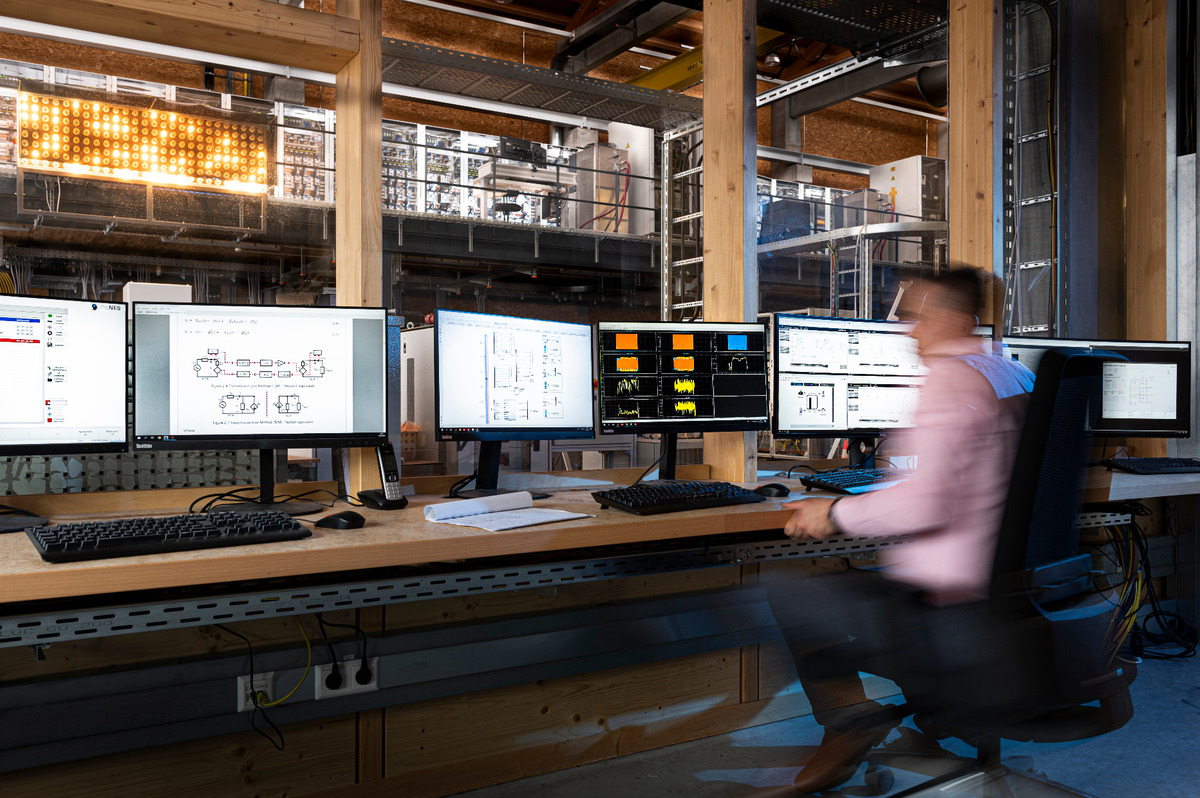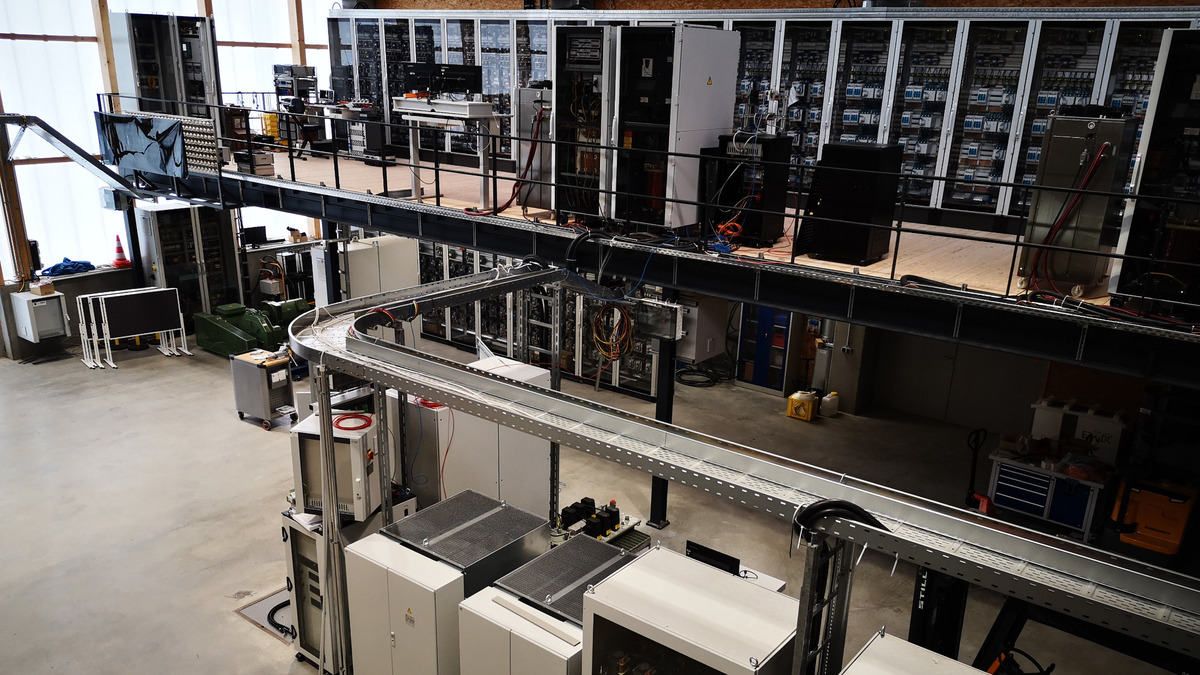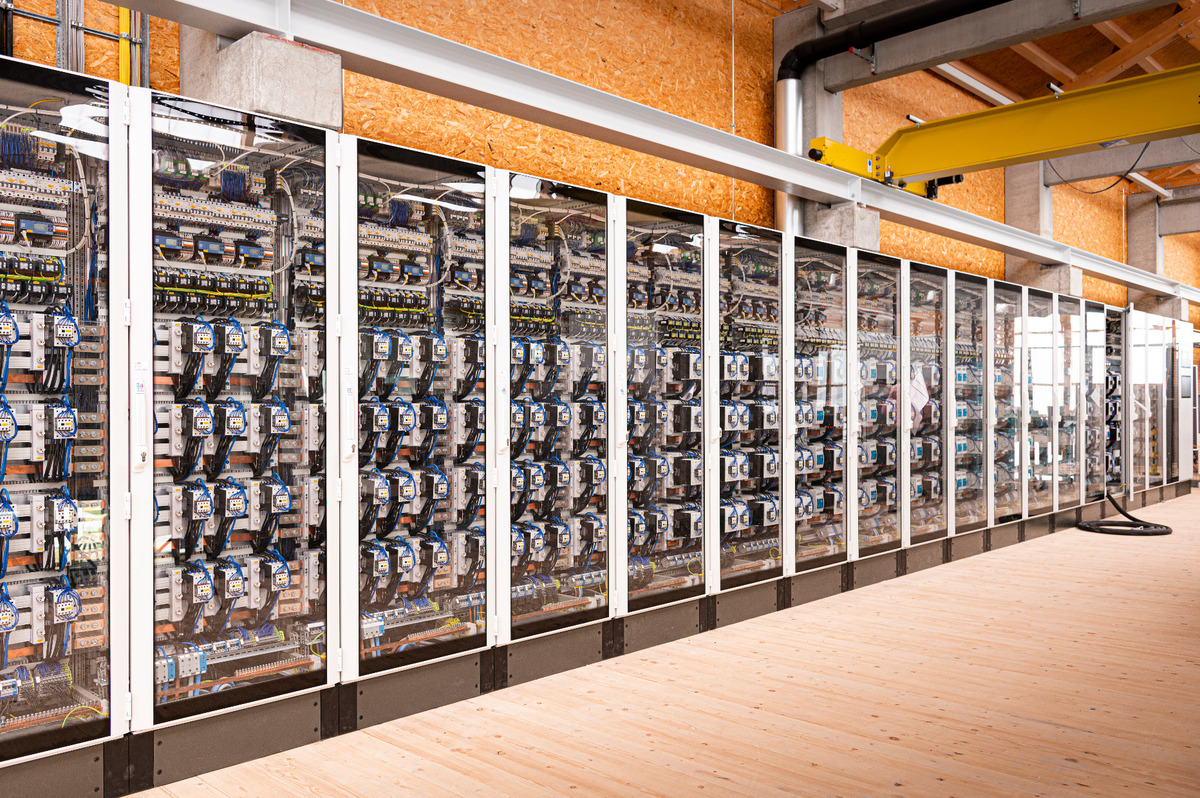Smart Energy System Control Laboratory (SESCL)
The Smart Energy System Control Laboratory combines theory with practice. Many questions of the energy transition can only be answered with extensive simulations and complex models of energy networks, feeders, storage facilities and consumers. Precise models of the plant components are an important prerequisite for this. The physical presence of the plants in the SESCL creates a constant reference to reality and thus facilitates the implementation of the research results in real network environments. Since the experimental field is galvanically isolated from the public power grid, control strategies in borderline areas can be approved and investigated there. In addition, operating points that approach the stability limits can be controlled. Such experiments would not be permitted in the public grid.
The energy transition cannot be planned on computers alone, nor can all new ideas be tested in the public power grid. SESCL was established with funds from the Baden-Württemberg Ministry of Science, Research and the Arts (MWK). In SESCL, representatives of the most important machines and devices of power grids and heat supply systems are installed. Because electricity will be of great importance in the heating market and for mobility in the future, heat pumps and charging stations, for example, were purchased and implemented.
Of course, only a limited number of components can be physically connected to a network in a laboratory environment. Therefore, adjacent power grids are simulated using Power Hardware in the Loop (PHIL) systems. Behind this there are fast computers and electronics that can realize a calculated power consumption or power injection. Within SESCL, the busbar matrix is the central element for the intelligent connection of the energy technology components, such as power generators, consumers, storage devices, lines and other network equipment. The busbar matrix allows new experiments to be interconnected and thus configured very quickly. 27 switchgear cabinets are filled by the required switchgear.
Research topics
- Integration of Distributed Renewable Energy Resources (DER) into a microgrid
- System stability analysis (voltage, frequency and rotor angle stability) in converter dominated grids
- Validation of new control strategies
- Behaviour of a microgrid in relation to the power grid
- Behaviour of largely autarkic cells (e.g. experimental houses) towards the microgrid
Equipment
→ to the detailed SESCL laboratory equipment
Busbar matrix as the central connecting element of all electrical components
- AC and DC busbar
- High frequency measurement of all connected electrical components
- Automation system
LLEC experimental buildings including their individual energy technology systems
- Heat pump house
- Power House
- Gas2Heat house
Consumer
- RLC loads
- Asynchronous machine
- Lighting installation
- Consumer as power hardware-in-the-loop system
Producer
- Network connection
- Gas generator
- Micro-CHP
- Photovoltaic systems
- Power amplifier as power hardware-in-the-loop system
Prosumer
- Supercaps
- Lithium-ion battery storage
- Flywheel mass storage
Reactive power components
- Capacitors
- Inductors
- Phase shifter
- FACTS (Flexible Alternating Current Transmission System)
Mobility
- Battery electric vehicles
- (V2G) charging stations for electric mobility
Network resources and other components
- Reproductions of management
- Transformers (rONT)
- AC/DC converters
- Converter
→ to the detailed SESCL laboratory equipment
Selected scientific publications
-
Characterization of grid-oriented control of heat pumps via SG-Ready
Beichter, S.; Süß, A.-C.; Galenzowski, J.; Dillmann, J.; Dietze, S.; Mikut, R.; Waczowicz, S.; Hagenmeyer, V.
2025. IET Conference Proceedings, 2025 (14), 2081–2085. doi:10.1049/icp.2025.1999 -
BEOP: A Framework Enabling Validation of Realworld Energy Management Systems
Beichter, S.; Beichter, M.; Nöthel, A.; Pinter, J.; Galenzowski, J.; Förderer, K.; Wiegel, F.; Moser, T.; Waczowicz, S.; Mikut R.; Hagenmeyer, V.
2025, June 22. 16th International Symposium on Power Electronics for Distributed Generation Systems (PEDG 2025), Nanjing, China, June 22–25, 2025 -
The Smart2DC Microgrid Laboratory at Karlsruhe Institute of Technology
Ekin, Ö.; Wiegel, F.; Spatafora, L.; Jumar, R.; Ghadrdan, M.; Waczowicz, S.; Carne, G. De; Hagenmeyer, V.
2025. 2025 IEEE 7thInternational Conference on DC Microgrids (ICDCM), 6 S., Institute of Electrical and Electronics Engineers (IEEE). doi:10.1109/ICDCM63994.2025.11144732 -
A Novel Digital Twin – based Framework and Methodology for Enhancing the Contribution of Loads to Frequency Control
Araúz, J.; Labonne, A.; Besanger, Y.; Wurtz, F.; Waczowicz, S.; Hagenmeyer, V.
2025. IEEE Access, 13, 128475–128491. doi:10.1109/ACCESS.2025.3590215 -
Intelligent Power Routing in Low-Voltage Grids for Efficient Utilization of Line Capacities
Çakmak, H. K.; Suriyah, M.; Leibfried, T.; Hagenmeyer, V.
2025. doi:10.36227/techrxiv.175021730.07412600/v1 -
Combined Frequency Control from Trains Thermal Inertia: An Assessment of Frequency Controllers Interaction
Araúz, J.; Wiegel, F.; Waczowicz, S.; Hagenmeyer, V.; Martinez, S.
2025. IEEE Open Journal of Power Electronics, 6, 464–473. doi:10.1109/OJPEL.2025.3547097 -
The Gap between Experiment and Simulation: Grid Forming Inverter Control during Islanding Transition
Baumgarten, K.; Wachter, J.; Wiegel, F.; Jumar, R.; Hagenmeyer, V.
2024. 2024 9th IEEE Workshop on the Electronic Grid (eGRID 2024) Santa Fe, New Mexico, USA, 19-21 November 2024, 1–6, Institute of Electrical and Electronics Engineers (IEEE). doi:10.1109/eGRID62045.2024.10842947 -
Integrating distributed energy resources in real-world sector-coupled microgrids: challenges, strategies, and experimental insights
Wiegel, F.; An, S.; Wachter, J.; Beichter, S.; Süß, A.-C.; Ekin, Ö.; Hagenmeyer, V.
2024. System Level Control and Optimisation of Microgrids. Ed.: A. Parisio, 147–173, Institution of Engineering and Technology (IET). doi:10.1049/PBPO149E_ch6 -
Scheduling Electric Currents in Converter-Dominated Power Grids with Time-Slotted Energy Packets
Schneider, K.; Schulz, D.; Helmig, D.; Wiegel, F.; Hagenmeyer, V.; Hiller, M.; Zitterbart, M.
2025. Energy Informatics – 4th Energy Informatics Academy Conference, EI.A 2024, Kuta, Bali, Indonesia, October 23–25, 2024, Proceedings, Part I. Ed.: B. Jørgensen, 3–20, Springer Nature Switzerland. doi:10.1007/978-3-031-74738-0_1 -
A Novel Approach for Removing Decaying DC Offset from Fault Current Signals Using Cumulative Sum – Fast Moving Average (CumSum-FMA) Hybrid Algorithm
Abel, P.; Wiegel, F.; Kyesswa, M.; Waczowicz, S.; Hagenmeyer, V.
2024. 2024 IEEE 15th International Symposium on Power Electronics for Distributed Generation Systems (PEDG), Luxemburg, 23rd-26th June 2024, 1–5, Institute of Electrical and Electronics Engineers (IEEE). doi:10.1109/PEDG61800.2024.10667422 -
Grid supporting nonlinear control for AC-coupled DC Microgrids
Ekin, Ö.; Perez, F.; Wiegel, F.; Hagenmeyer, V.; Damm, G.
2024. 2024 IEEE Sixth International Conference on DC Microgrids (ICDCM), Columbia, SC, USA, 05-08 August 2024, Institute of Electrical and Electronics Engineers (IEEE). doi:10.1109/ICDCM60322.2024.10664838 -
Hardware-Based Microgrid Coupled to Real-Time Simulated Power Grids for Evaluating New Control Strategies in Future Energy Systems
Kyesswa, M.; Wiegel, F.; Wachter, J.; Kühnapfel, U.; Waczowicz, S.; Hagenmeyer, V.
2024. arxiv. doi:10.48550/arXiv.2409.01809 -
Forecasting Electric Vehicle Charging Behavior in Workplace Charging Infrastructure with Limited Privacy-Restricted Real Data
Stein, A.; Beichter, S.; Hage, J.; Beichter, M.; Schwarz, B.; Waczowicz, S.; Hiller, M.; Hagenmeyer, V.; Munzke, N.; Mikut, R.
2024. 2024 IEEE Transportation Electrification Conference and Expo (ITEC), 7 S., Institute of Electrical and Electronics Engineers (IEEE). doi:10.1109/ITEC60657.2024.10598951 -
Experimental Analysis of Immersion & Invariance Adaptive Control for an Interleaved DC/DC Boost Converter with Unknown Load Type
Wachter, J.; Gröll, L.; Hagenmeyer, V.
2023. 2023 IEEE PES Innovative Smart Grid Technologies Europe (ISGT EUROPE), 6 S., Institute of Electrical and Electronics Engineers (IEEE). doi:10.1109/ISGTEUROPE56780.2023.10407194 -
Application of Model-Free Control to Reduce the Total Harmonic Distortion of Inverters
Wachter, J.; Gröll, L.; Hagenmeyer, V.
2023. 2023 8th IEEE Workshop on the Electronic Grid (eGRID), Karlsruhe, Germany, 16-18 October 2023, Institute of Electrical and Electronics Engineers (IEEE). doi:10.1109/eGrid58358.2023.10380817 -
Towards a Real-World Dispatchable Feeder
Beichter, S.; Beichter, M.; Werling, D.; Galenzowski, J.; Weise, V.; Hildenbrand, C.; Wiegel, F.; Mikut, R.; Waczowicz, S.; Hagenmeyer, V.
2023. 2023 8th IEEE Workshop on the Electronic Grid (eGRID), Karlsruhe, Germany, 16-18 October 2023, 1–6, Institute of Electrical and Electronics Engineers (IEEE). doi:10.1109/eGrid58358.2023.10380834 -
Experimental validation of demand side response rates for frequency control
Casasola-Aignesberger, L.; Wiegel, F.; Waczowicz, S.; Hagenmeyer, V.; Martinez, S.
2023. 2023 8th IEEE Workshop on the Electronic Grid (eGRID), Karlsruhe, Germany, 16-18 October 2023, 1–6, Institute of Electrical and Electronics Engineers (IEEE). doi:10.1109/eGrid58358.2023.10380814 -
Survey of real-world grid incidents – opportunities, arising challenges and lessons learned for the future converter dominated power system
Wachter, J.; Gröll, L.; Hagenmeyer, V.
2023. IEEE Open Journal of Power Electronics, 5, 50–69. doi:10.1109/OJPEL.2023.3343167 -
A Real-Time PHIL Implementation of a Novel Nonlinear Distributed Control Strategy for a Multi-Terminal DC Microgrid
Ekin, Ö.; Perez, F.; Damm, G.; Hagenmeyer, V.
2023. 2023 IEEE Belgrade PowerTech, Belgrade, Serbia, 25-29 June 2023, Institute of Electrical and Electronics Engineers (IEEE). doi:10.1109/PowerTech55446.2023.10202843 -
Comparison of Four-Switch Buck-Boost and Dual Active Bridge Converter for DC Microgrid Applications
Ekin, Ö.; Arena, G.; Waczowicz, S.; Hagenmeyer, V.; Carne, G.
2022. 2022 IEEE 13th International Symposium on Power Electronics for Distributed Generation Systems (PEDG), 1–6, Institute of Electrical and Electronics Engineers (IEEE). doi:10.1109/PEDG54999.2022.9923074 -
Smart Energy System Control Laboratory : a fully-automated and user-oriented research infrastructure for controlling and operating smart energy systems = Smart Energy System Control Laboratory : hochgradig automatisierte und nutzerorientierte Forschungsinfrastruktur zur Steuerung und zum Betrieb intelligenter Energiesysteme
Wiegel, F.; Wachter, J.; Kyesswa, M.; Mikut, R.; Waczowicz, S.; Hagenmeyer, V.
2022. at - Automatisierungstechnik, 70 (12), 1116–1133. doi:10.1515/auto-2022-0018 -
Comparison of Four-Switch Buck-Boost and Dual Active Bridge Converter for DC Microgrid Applications
Ekin, Ö.; Arena, G.; Waczowicz, S.; Hagenmeyer, V.; Carne, G.
2022, June 26. 13th International Symposium on Power Electronics for Distributed Generation Systems (PEDG 2022), Kiel, Germany, June 26–29, 2022 -
A Lightweight User Interface for Smart Charging of Electric Vehicles: A Real-World Application
Meisenbacher, S.; Schwenk, K.; Galenzowski, J.; Waczowicz, S.; Mikut, R.; Hagenmeyer, V.
2021. 2021 9th International Conference on Smart Grid and Clean Energy Technologies (ICSGCE), 57–61, Institute of Electrical and Electronics Engineers (IEEE). doi:10.1109/ICSGCE52779.2021.9621604 -
Adaptive Feedforward Control for DC/DC Converters in Microgrids - A Power Hardware in the Loop Study
Wachter, J.; Gröll, L.; Hagenmeyer, V.
2021. 9th International Conference on Smart Grid (icSmartGrid), 29th June - 01st July 2021, Sebútal, Portugal, 49–56, Institute of Electrical and Electronics Engineers (IEEE). doi:10.1109/icSmartGrid52357.2021.9551250 -
Smart Charging of Electric Vehicles with Cloud-based Optimization and a Lightweight User Interface – A Real-World Application in the Energy Lab 2.0: Poster
Meisenbacher, S.; Schwenk, K.; Galenzowski, J.; Waczowicz, S.; Mikut, R.; Hagenmeyer, V.
2021. e-Energy ’21: The Twelfth ACM International Conference on Future Energy Systems Virtual Event Italy 28 June 2021- 2 July 2021, 284–285, Association for Computing Machinery (ACM). doi:10.1145/3447555.3466571 -
Power Hardware In the Loop infrastructure at KIT
Hubschneider, S.; Waczowicz, S.; Wiegel, F.; Karrari, S.; Sousa, W. T. B. de; Carne, G. de; Geisbüsch, J.; Hiller, M.; Leibfried, T.; Hagenmeyer, V.; Noe, M.
2020, June 18. RT20: Opal-RT’s 12th Conference on Real-Time Simulation (2020), Online, June 18, 2020 -
Information and communication technology in energy lab 2.0: Smart energies system simulation and control center with an open-street-map-based power flow simulation example
Hagenmeyer, V.; Cakmak, H. K.; Düpmeier, C.; Faulwasser, T.; Isele, J.; Keller, H. B.; Kohlhepp, P.; Kühnapfel, U.; Stucky, U.; Waczowicz, S.; Mikut, R.
2016. Energy Technology, 4 (1), 145–162. doi:10.1002/ente.201500304
Head of Research Platform Energy









